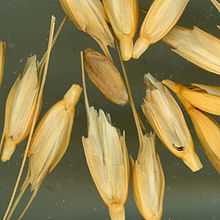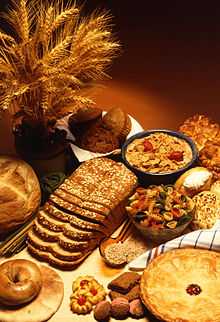Shattering (agriculture)


In the history of crop domestication, several important advances have involved a mutation in a crop plant that reduced shattering — instead of the seeds being dispersed as soon as they were ripe, the mutant plants retained the seeds for longer, which made harvesting much more effective.
A particularly important mutation that was selected very early in the history of agriculture removed the "brittle rachis" problem from wheat.[1] A ripe head ("ear") of wild-type wheat is easily shattered into dispersal units when touched, or blown by the wind, because during ripening a series of abscission layers forms that divides the rachis into short segments, each attached to a single spikelet (which contains 2–3 grains along with chaff).
A different class of shattering mechanisms involves dehiscence of the mature fruit, which releases the seeds.
Current research priorities to understand the genetics of shattering include the following crops:
References
- ↑ Dorian Q. Fuller and Robin Allaby (2009). "Seed Dispersal and Crop Domestications: Shattering, Germination and Seasonality in Evolution under Cultivation". Annual Plant Reviews 38: 238–295. doi:10.1002/9781444314557.ch7.
- ↑ Kandemir, N.; Kudrna, D.A.; Ullrich, S.E.; Kleinhofs, A. (2000). "Molecular marker assisted genetic analysis of head shattering in six-rowed barley". TAG Theoretical and Applied Genetics 101 (1): 203–210. doi:10.1007/s001220051470.
- ↑ Ivan N. FESENKO 2006. Non-shattering accessions of Fagopyrum tataricum Gaertn. carry recessive alleles at two loci affecting development of functional abscission layer. Fagopyrum 23: 7-10
- ↑ Brenner, D.M. 2002. Non-shattering grain amaranth populations. p. 104–106. In: J. Janick and A. Whipkey (eds.), Trends in new crops and new uses. ASHS Press, Alexandria, VA.
- ↑ S. Hossain, G.P. Kadkol, R. Raman, P.A. Salisbury, and H. Raman. "Breeding Brassica napus for Shatter Resistance". Plant Breeding. doi:10.5772/29051. ISBN 978-953-307-932-5.
| |||||||||||||||||||||||||||||||||||||||||||||
| |||||||||||||||||||||||||||||||||||||||||||||

